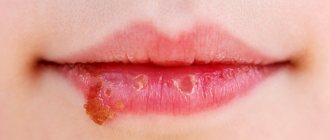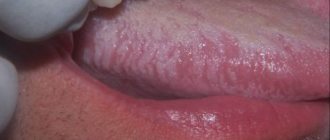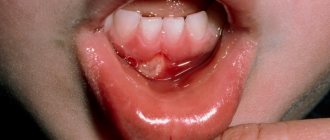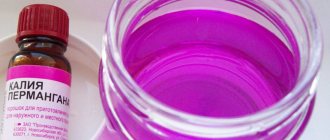Herpes is the most common viral infection that exists for a long time in the body, mainly in a latent state. The causative agent of the disease is dermatoneurotropic DNA - containing the herpes simplex virus. Once in the body, the herpes simplex virus persists throughout life, periodically causing relapses of the disease, which, as with primary herpes, occur with different degrees of severity and location of the lesion. Primary herpes in 80% of patients is asymptomatic. A few days after infection, specific antibodies appear in the blood serum. More than 85% of 3-year-old children have virus-neutralizing antibodies in their blood serum, but the presence of antibodies does not always contribute to protection against secondary manifestations of herpes.
Etiology of herpes in children
There are several known ways of infection of the herpes simplex virus in children:
- air-drip;
- contact (through direct and indirect contact);
- transplacental;
- transfusion
The disease is contagious to persons not previously infected with the virus. The herpes simplex virus enters the body through the mouth, nasopharynx, eyes, genitals, infecting the skin or mucous membranes. A number of triggering factors have been identified that can provoke relapses: hypothermia, trauma to the oral mucosa, neuropsychic stress, overheating in the sun, taking medications, climate change. The herpes simplex virus is characterized by dermatoneurotropism, it has a pronounced affinity for the skin, mucous membranes and nervous tissue. It is in a free static non-productive state in the cells of the paravertebral sensory ganglion. Under the influence of a triggering factor, the virus from the centrifugal ganglion migrates along the axon of the peripheral nerve and causes active reproduction of the herpes simplex virus in epithelial cells. Reproduction and release of the herpes simplex virus from the ganglion occurs daily, but when it reaches the skin and mucous membranes, it is eliminated by defense mechanisms. Violation of the integrity of the mucous membranes and skin is important for the development of the disease.
There is no seasonality in the occurrence of the disease; children get sick equally often in winter, autumn, spring and even summer. An important role in the occurrence of relapse of herpes is played by the state of local and general immunity. The proposed mechanisms causing reactivation of the herpes simplex virus include provocations by specific physical or emotional factors, and seasonal periods of weakened immunity. Triggering factors can be acute respiratory infections, influenza, acute diseases of the gastrointestinal tract, neuroendocrine diseases, and emotional stress.
Herpes simplex manifests itself in two forms: acute herpetic stomatitis and chronic recurrent herpetic stomatitis.
Herpes simplex virus types 1 and 2
The term “herpes infection” (HI) is usually used to refer to diseases that are caused by HSV-1 and HSV-2. The source of HSV infection are sick people with various forms of the disease, including latent ones, as well as virus carriers.
HSV-1 is transmitted by airborne droplets and contact. When the virus gets on the skin during a cough or sneeze, it is contained in droplets of saliva and survives for an hour. On wet surfaces (washbasin, bathtub, etc.) it remains viable for 3-4 hours, which is often the cause of disease outbreaks in preschool institutions. Infection can occur through kissing, as well as through household items that are infected with the saliva of a patient or virus carrier. HSV-2 is transmitted sexually or vertically. With the latter, infection occurs during childbirth (contact with the mother's birth canal), transplacentally or through the cervical canal in the uterine cavity. Due to the fact that viremia occurs during generalization of infection, transfusion or parenteral transmission of HSV-2 infection is also possible. HSV-2 usually causes genital and neonatal herpes.
Children are most susceptible to GI between 5 months and 3 years of age. Depending on the mechanism of infection, acquired and congenital forms of HI are distinguished. Acquired HI can be primary and secondary (recurrent), localized and generalized. A latent form of GI is also isolated.
No infection has such a variety of clinical manifestations as the herpes virus. It can cause damage to the eyes, nervous system, internal organs, mucous membrane of the gastrointestinal tract, oral cavity, genitals, can cause cancer, and has a certain significance in neonatal pathology and the occurrence of hypertension. The spread of the virus in the body occurs through hematogenous, lymphogenous, and neurogenic routes.
The frequency of primary herpesvirus infection increases in children after 6 months of life, when antibodies received from the mother disappear. The peak incidence occurs at the age of 2-3 years. HI often occurs in newborns; according to a number of authors, it is diagnosed in 8% of newborns with general somatic pathology and in 11% of premature infants.
According to WHO, diseases caused by the herpes simplex virus (HSV) are the second leading cause of death from viral infections after influenza. Solving the problem of diagnosing and treating herpesvirus infection with manifestations on the oral mucosa is one of the most important tasks of practical medicine.
In the last decade, the importance of herpesvirus diseases as a public health problem has been constantly growing throughout the world. Members of the human herpesvirus family infect up to 95% of the world's population.
Primary forms of GI include: infection of newborns (generalized herpes, encephalitis, herpes of the skin and mucous membranes), encephalitis, gingivostomatitis, Kaposi's eczema herpetiformis, primary herpes of the skin, eye, herpetic panaritium, keratitis. Primary HI occurs due to initial human contact with HSV. As a rule, this occurs in early childhood (up to 5 years). In adults aged 16-25 years who do not have antiviral immunity, primary HI may more often be caused by HSV-2. 80-90% of initially infected children carry the disease latently, and only in 10-20% of cases are clinical manifestations of the disease observed.
Secondary, recurrent forms of GI are herpes of the skin and mucous membranes, ophthalmic herpes, and genital herpes.
Acute herpetic stomatitis in children
This stomatitis occupies one of the leading places in childhood infectious pathology; it is more common than scarlet fever, measles and mumps. It is considered as a manifestation of primary infection with the herpes simplex virus in the oral cavity. Children and teenagers get sick. The disease is contagious to persons not previously infected with the virus. In preschool institutions, school classrooms, and hospital wards, during an epidemic outbreak, up to 75% of children can get sick. Transmission of infection occurs by contact and airborne droplets. In the first 6 months of life after birth, herpes practically does not occur, which is due to the presence in the child’s blood of antiherpetic antibodies during this period, transplacentally transmitted to him from the mother. The course of the disease in the child is acute, there is a high temperature, a disturbance in the general condition, an increase in ESR, leukopenia or leukocytosis. In the pathogenesis of the disease, periods are distinguished: prodromal, catarrhal, periods of rashes and extinction of the disease.
- PRODROME PERIOD OF ACUTE HERPETIC STOMATITIS IN CHILDREN
The prodromal period is manifested by a burning sensation, piercing, itching, a feeling of tension, rawness and numbness in the areas of future appearance of the rash on the skin and mucous membrane of the mouth and lips. There is loss of appetite, poor sleep, and malaise. The child even refuses his favorite food, becomes sedentary and inactive, and, as a rule, the mother pays attention to his behavior.
Lymph nodes - submandibular, chin and cervical - can be enlarged, their palpation is painful.
- CATARHAL PERIOD OF ACUTE HERPETIC STOMATITIS IN CHILDREN
The catarrhal period is characterized by hyperemia and swelling of the oral mucosa and gingival margin. The child may complain of discomfort or pain in the mouth when eating and refuse favorite foods. Infants refuse to breastfeed or turn into lazy suckers.
Lymph nodes - submandibular, submental and cervical - are enlarged, their palpation is painful. The mucous membrane of the gums is swollen, hyperemic, and the gums bleed when touched. There is pronounced hypersalivation, bad breath, and the oral fluid is viscous and viscous.
- PERIOD OF ACUTE HERPETIC STOMATITIS RASHES IN CHILDREN
During the period of rashes, single or multiple lesions appear on the oral mucosa and skin in the form of bright hyperemic spots, against which small blisters quickly form, which can merge into large blisters. The formation of bubbles is accompanied by tingling in the oral mucosa and red border of the lips. They are located in groups and contain a clear liquid that becomes cloudy over time.
Large blisters burst quickly enough to form painful erosions with uneven contours. The erosions are covered with fibrinous plaque. Blisters localized on the lips and skin, after opening, contribute to the formation of erosions or gray-yellow crusts. The area of damage to the oral mucosa depends on the severity of the disease. The mucous membrane of the oral cavity is swollen, hyperemic, in the first 2 days hypersalivation is pronounced, which can be replaced by dryness. Erosive elements and bubbles can be multiple or single, i.e. the process can be limited (herpetic glossitis, herpetic tonsillitis), or widespread, completely affecting not only the mucous membrane of the oral cavity, but also the mucous membrane of the nasopharynx, tonsils, red border of the lips and the skin around the lips, as well as the wings of the nose. Without treatment, erosions epithelialize in 7-12 days.
The mucous membrane of the gums is also swollen, hyperemic, the gums bleed when touched, catarrhal gingivitis easily transforms into ulcerative necrotic. The submandibular, submental and cervical lymph nodes are enlarged, their palpation is painful.
- PERIOD OF EXHAUSTION OF ACUTE HERPETIC STOMATITIS IN CHILDREN
The period of extinction (reconvalescence) of acute herpetic stomatitis in children is characterized by an improvement in the general condition and dental health, hyperemia and swelling of the oral mucosa decreases and disappears, and active epithelization of aphthous elements is observed.
There are 3 degrees of severity of the disease.
- MILD DEGREE OF ACUTE HERPETIC STOMATITIS IN CHILDREN
A mild degree of acute herpetic stomatitis in children occurs with the absence of symptoms of intoxication of the body, however, with a satisfactory general condition, low-grade fever is possible. The mucous membrane of the oral cavity is swollen, hyperemic, the gums bleed, single and grouped small aphthae appear almost simultaneously in different areas of the mucosa, which quickly epithelialize.
- AVERAGE DEGREE OF ACUTE HERPETIC STOMATITIS IN CHILDREN
The average degree of acute herpetic stomatitis occurs with severe intoxication. During the prodromal period, malaise, weakness, headache, nausea, and temperature of 38.5C are observed. The submandibular lymph nodes are enlarged, less often the submental and cervical ones, their palpation is painful. The mucous membrane of the oral cavity is swollen, hyperemic, the saliva is viscous and viscous, the dentogingival papillae are swollen and bleed when touched. In various parts of the oral mucosa there are single or grouped aphthae. Increased ESR, leukopenia or leukocytosis are noted.
- SEVERE DEGREE OF ACUTE HERPETIC STOMATITIS IN CHILDREN
Severe degrees of acute herpetic stomatitis in children, already in the prodromal period, are characterized by the presence of all the signs of an infectious disease - apathy, adynamia, headache, nausea, vomiting, since the herpes virus is encephalotropic. Body temperature 38-40C. Pallor of the skin is noted. The submandibular, submental and cervical lymph nodes are enlarged, their palpation is painful. The oral mucosa is swollen, hyperemic, covered with a large number of aphthous elements that recur. The lips, mucous membrane of the cheeks, soft and hard palate, tongue, and gingival margin are affected. Dental papillae are swollen and bleed when touched. In case of insufficient oral care, catarrhal gingivitis easily transforms into ulcerative-necrotic. Saliva is viscous and viscous, the reaction of saliva is acidic, pH = 5.8-6.4. Leukopenia is detected in the blood, the number of band neutrophils increases, eosinophilia, and increased ESR are noted. Protein is detected in the urine.
IN WEAKENED CHILDREN WITH CHRONIC, LONG-TERM SOMATIC DISEASES, HERPES SIMPLE TAKES A PERMANENT COURSE, LIZEROS SIMPLE BECOMES A RECURRENT DISEASE, IN SOME CHILDREN, RECURRENCES ARE OBSERVED I DO UP TO 5 TIMES A YEAR.
Cytomegalovirus infection
An infectious disease that is caused by cytomegalovirus (CMV) and is characterized by a variety of clinical forms (from asymptomatic to severe generalized with damage to many organs) and course (acute or chronic). CMV transmission factors can be almost all biological substrates and human secretions that contain the virus: blood, saliva, urine, cerebrospinal fluid, vaginal secretions, sperm, amniotic fluid, breast milk. Potential sources of infection are organs and tissues in transplantology, as well as blood and its products in transfusiology. Routes of transmission of CMV infection: airborne, sexual, vertical and parenteral.
There are congenital and acquired forms of CMV infection. Congenital CMV infection. During antenatal infection of the fetus, infection occurs predominantly transplacentally. During intrapartum infection, CMV enters the body through aspiration of infected amniotic fluid or secretions from the mother's birth canal.
In older children, acquired CMV infection occurs in a subclinical form in 99% of cases. The most common manifestation of this form of CMV infection in children over one year of age is mononucleosis-like syndrome. As a rule, a clinical picture of acute respiratory disease is observed in the form of pharyngitis, laryngitis, and bronchitis.
Infections caused by the sixth, seventh and eighth types of herpes viruses Type six herpes viruses (HHV-6) can cause erythematous and roseolous rashes (sudden exanthema), lesions of the central nervous system and bone marrow in immunocompromised children. Herpesvirus type seven (HHV-7) causes neonatal exanthema
For the diagnosis of herpes infection, cytological, immunofluorescent, serological and PCR methods are valuable. Virological testing for herpes infection reveals complement-fixing antibodies to HSV-1 or -2 in the mother's blood, fetal cord blood and amniotic fluid. PCR method. The material for testing for herpes is blood, throat swabs, the contents of blisters, ulcers, and urine.
The study of specific antibodies of various subclasses: IgM, IgG1-2, IgG3 and IgG4 to herpes viruses is important. The detection in the blood serum of children of specific immunoglobulins M, IgG3, IgG1-2 in a titer > 1:20, viral antigen and specific immune complexes with antigen indicates the severity of the infectious process (active phase), and the determination of only specific IgG4 is regarded as the latent phase of infection or carriage of maternal antibodies.
Chronic recurrent hepatic stomatitis in children
Chronic recurrent hepatic stomatitis in children is characterized by complaints of burning and pain in the oral cavity when eating and talking. Sometimes parents pay attention to how the child treats food intake (refuses to eat completely or eats very little). A decrease in the child’s activity also becomes noticeable, tearfulness and irritability appear.
Upon examination, single rashes of aphthous elements or a group of closely spaced small blisters are revealed on the red border of the lips, the skin of the lips, on the wings of the nose, the anterior part of the palate, the tip of the tongue, the genitals and the mucous membrane of the eyes. The lips and oral mucosa are favorite sites for herpes, especially in areas that are normally keratinized.
On the first day of the disease, areas of hyperemia or diffuse hyperemia appear on the oral mucosa, against which white, finely focused spots form. Spider veins are observed on the periphery of these spots. Against the background of the hyperemic mucous membrane of the oral cavity, whitish areas are clearly contoured and turn into necrotic foci, tightly fused to the underlying tissues. A rim of hyperemia surrounds the necrotic area and is a demarcation line.
In the next 2-3 days, the rim of the hyperemia becomes pale and erosion forms due to maceration of the damaged area. On the upper and lower lips there are vesicles, single or in groups, containing a clear liquid. Over time, their contents darken. The bubbles can merge into large blisters up to 1.5 cm in diameter, which burst easily and the contents shrink into yellow-gray crusts. Often the bubbles burst with the formation of bright red erosions with jagged edges. The mucous membrane of the oral cavity is swollen, hyperemic, blisters on the mucous membrane open in the first hours after their appearance, erosions in their place have an irregular scalloped shape and are covered with a fibrinous film. In severe cases of the disease, malaise, muscle pain, chills, and a temperature of 38-39C appear.
The number of relapses per year depends on the resistance of the child’s body.
Treatment of herpes
Treatment of herpes simplex should be comprehensive, ethionatogenetic.
General treatment of herpes
- High calorie diet.
- Drink plenty of fluids.
- General restorative therapy - vitamin C, calcium supplements (calcium gluconate, calcium glycerophosphate, calcium lactate, calcium chloride), fish oil for 1-2 weeks. Doses are selected individually, taking into account the age, weight and general condition of the child.
- Desensitizing therapy (diphenhydramine, suprastin, pipolfen, diprazine, tavegil, diazolin, fenkarol, etc.) for 1-2 weeks
- Antiviral drugs (bonafton, tebrofen, florenal, Megosin, alpizarin, remantadine, metisazone, riodoxol, gossypol, leukocyte interferon, biosynthetic leukocyte drug interlock, deoxyribonuclease, interferon, helepin, modimunal, acyclovir, Zovirax, Virolex) for oral and local administration in the form of applications. The dose is selected individually according to the age, weight, and general condition of the child.
- Immunocorrective therapy. Gamma globulin or histaglobin is prescribed 1-2 ml intramuscularly 2 times a week, for a course of 1-2 injections, to increase the body's defenses. You can use dekaris, taktivin, timoptin (the dose is selected individually according to the age, weight of the child and based on the general condition), Immunal - 5-15 drops, 2-3 times a day for 1-2 weeks (the dose is selected individually according to the age of the child ).
- A specific antiherpetic polyvaccine (during the period between relapses), the combined administration of a vaccine and parenteral administration of interferon inducers (ridostine) are effective.
Local treatment of herpes
- The oral mucosa should be anesthetized with warm anesthetics, then antiseptically treated with warm antiseptics, in particular 0.5-1% solution of trimecaine or lidocaine, 4% solution of pyromecaine on glucose, 0.5-1% solution of novocaine with urotropine, 5-10 % anesthetic emulsion, 0.02% furatsilin solution, 0.02% ethacridine lactate solution, 0.01% dimexide solution, 0.1% etonium solution. It is possible to use an antiseptic together with an anesthetic in a 1:1 ratio (the solution is prepared before use) in the form of irrigation, baths, applications 3-4 times a day.
- Applications of proteolytic enzymes are carried out once a day for 5-10 minutes. It is recommended to use lysozyme, chymotrypsin, chymopsin, pancreatin, deoxyribonuclease, which has not only a cleansing effect of necrotic masses, but also an antiviral effect.
- Applications of antiviral ointments are used 3-4 times a day for 10-15 minutes. It is recommended to use 1% florenal, 0.5% tebrofen, 1% riodoxol and 0.5-1% oxolinic ointments, as well as 3% gossypol liniment, 0.1% gossypol solution, 0.5% bonaftone ointment, 5% interferon ointment , ointments Zovirax and acyclovir. Interferon in solution should be instilled into the oral cavity and each nostril, 1-2 drops 3-4 times a day. The course of treatment is individual for each child.
- Applications of keratoplasty preparations should be prescribed from the moment of epithelization of erosions 2-3 times a day for 10-15 minutes (vitamin A in oil, vitamin E in oil, Shostakovsky balm, carotolin, rosehip oil and sea buckthorn oil). The course of treatment is individual for each child.
- They also use applications of agents that stimulate local immunity (1% sodium nucleinate solution, 5-10% galascorbine solution, 5% methyluracil ointment, 10% methyluracil emulsion), for 10-15 minutes 2-3 times a day. The course of treatment is individual for each child. In addition, iimudon is prescribed, a drug prepared from a mixture of lysates of various microorganisms and which is a polyvalent complex of antibodies. It stimulates the defenses of the oral mucosa by increasing the activity of polymorphonuclear leukocytes, increasing the number of slgA, increasing the activity and content of lysozyme in the oral fluid. Immudon is prescribed in the form of tablets for resorption in the oral cavity, 5-8 pieces per day. The course of treatment is 10-16 days. In the acute period, during the period of exacerbation and with severe pain - 8 tablets per day. In the remission phase, the drug should be used as a prophylactic agent, 5 tablets per day for 2 weeks.
- Physiotherapeutic treatment is prescribed from the first day of the disease (irradiation with a heliumene laser or ultraviolet No. 3-5) daily or every other day.
Prevention of herpes
Prevention of herpes simplex comes down to fulfilling the following conditions to avoid the spread of viral infection in children's groups:
- isolation of a patient with a viral disease from the team, even with a mild degree of the disease;
- elimination of chronic foci of infection;
- prophylactic use of antiviral ointments during an influenza epidemic by putting it in the nose 1-2 times a day;
- taking desensitizing drugs during an influenza epidemic (diphenhydramine, suprastin, pipolfen, diprazine, tavegil, diazolin, fenkarol, etc.) in the amount of a one-time pediatric dose per day; preventive course – 3-5 days;
- hardening the child, walks and games in the fresh air, gymnastics.
Varicella zoster infection
Varicella-zoster virus causes chickenpox and herpes zoster. The source of infection for chickenpox can only be a person with chickenpox or herpes zoster, including the last 24-48 hours of the incubation period. Convalescent chickenpox remains infectious for 3-5 days after the skin rash stops. The disease cannot be transmitted through a third party. Intrauterine infection with chickenpox is possible in the case of a pregnant woman. Chickenpox can occur at any age, but in modern conditions the maximum number of patients occurs in children aged 2 to 7 years. Herpes zoster develops after primary infection with the Varicella-zoster virus, after the infection passes into a latent form, in which the virus is localized in the spinal, trigeminal, sacral and other nerve ganglia. Endogenous reactivation of the infection is possible.
Treatment of herpes:
- Anesthesia (egg white + 2% novocaine, anesthesin + peach oil, 0.5-1% solution of trimecaine or lidocaine, 4% solution of pyromecaine on glucose, 0.5-1% solution of novocaine with urotropine,).
- Enzymes (trypsin, lysozyme, chymotrypsin, chymopsin, pancreatin, deoxyribonuclease)
- Antiseptic treatment (0.5-1% hydrogen peroxide solution, 0.06% chlorhexedine solution). Parents' signature: Ivanova.
- Antiherpetic ointments (0.25% oxaline ointment, 1% florenal, 0.5% tebrofen, 1% riodoxol, as well as 3% gossypol liniment, 0.1% gossypol solution, 0.5% bonaftone ointment, 5% interferon ointment, ointments Zovirax and acyclovir). All this 5-6 times a day. This is done for 4-5 days.
- 6th day.
- leave as needed.
- No need.----
- we leave it too.
- keratoplatics (vitamin A in oil, vitamin E in oil, Shostakovsky balm, carotolin, rosehip oil and sea buckthorn oil, vitaon)










